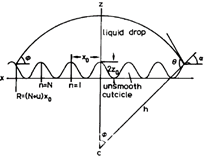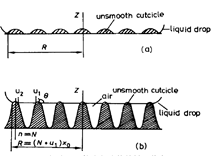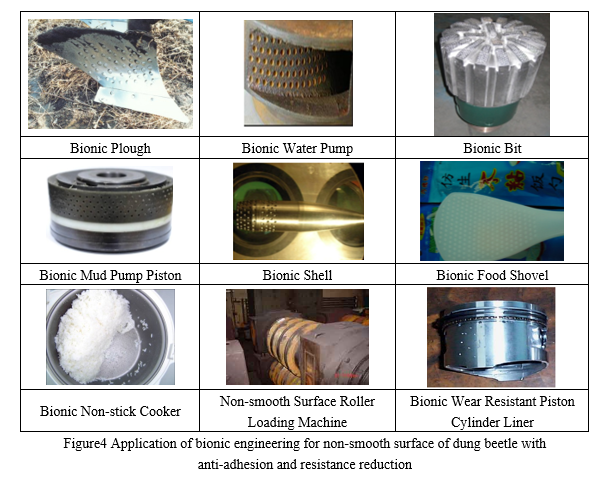The body surfaces of dung beetle normally have geometrically non-smooth or rough structures that will be useful to reduce contact area with soil and improve its hydrophobicity. As a result, both the adhesive and frictional forces between the animal body surface and the soil are reduced. The bionic research on anti-adhesion and resistance reduction of the non-smooth surface of dung beetles has been applied in agriculture, construction, mining and electric power, and has been extended to many engineering fields. It has obvious advantages in the multi-functional bionics in non-soil media, such as air, water, oil, and rock, showing their vast development potentials and extensive application prospect.
Dung beetles belong to the Coleoptera, superfamily Scarabaeoidea. After a long period of evolution, it has adapted to the sticky and wet environment. Dung beetles have a unique ability to dig holes. Generally, the depth of holes is over 80 cm, and some of them are over 2 m deep. The adult dung beetles are 40 mm to 80 mm long, oval, black, shiny, and hard. The clypeus is similar to bulldozer plate, and its cutting angle is 52°51'- 45° under normal conditions, and the cutting rear angle is 35°30'- 27°40', which is similar to the cutting angle range of the general bulldozer shovel. Its forefoot has evolved into a digging foot. Its tibia is broad and flat with hard teeth structures in edge, which like a rake and is suitable for excavation.



Figure1 Various non-smooth morphologies on head and pronotum of dung beetle
The body surfaces of dung beetle normally have geometrically non-smooth or rough structures from macroscale to mesoscale or microscale, such as convex, concave, squama, ripple. The interactions between their nonsmooth body surface and the soil can produce microvibration effect, discontinuous water-film effect and air-film effect at the interface. This will generate microvibrations at the adhesion interface with certain frequencies and amplitudes, which will not only decrease the contact area and static contact time, but will also result in the discontinuous distribution of the water film, hence generating some air films in the interface between the animal body and the soil. As a result, both the adhesive and frictional forces between the animal body surface and the soil are reduced.
The shape of the clypei of dung beetle decreases resistance during earth cutting and burrowing. In addition, dung beetle can automatically reduce resistance by adjusting the wedge angle through rotation of its head to execute efficiently different functions such as bulldozing and earth cutting. By applying a biomimetic curved surface as the stress-bearing surface, adjusting the angle of the components, and switching between various soil-engaging components based on slide cutting principles, the soil-engaging components can be functionally optimized and structurally innovated to minimize resistance.


Figure2 Non-smooth Surface Model Figure3 Interface state between ideal non-smooth surface and liquid
The bionic research on anti-adhesion and resistance reduction of the non-smooth surface of dung beetles has been applied in agriculture, construction, mining and electric power, and has been extended to many engineering fields. It has obvious advantages in the multi-functional bionics in non-soil media, such as air, water, oil, and rock, showing their vast development potentials and extensive application prospect.

[1] Ren L Q. Progress in the bionic study on anti-adhesion and resistance reduction of terrain machines. Sci China Ser E-Tech Sci, 2009, 52(2):273-284
[2] 任露泉. 地面机械脱附减阻仿生研究进展. 中国科学 E 辑: 技术科学 2008, 38(9): 1353-1364
[3] 程红, 孙久荣, 李建桥, 任露泉. 臭蜣螂体壁表面结构及其与减粘脱附功能的关系. 昆虫学报,2002,昆虫学报,45(2), 175-181.
[4] 任露泉, 佟金, 李建桥, 等. 松软地面机械仿生理论与技术. 农业机械学报, 2000, 31(1): 5-9
[5] 任露泉, 陈德兴, 陈秉聪. 土壤粘附研究概述. 农业工程学报, 1990, 6(1): 1-7
[6] Ren L Q, Tong J, Li J Q, et al. Soil adhesion and biomimetics of soil-engaging components: A review. J Agr Eng Res, 2001, 79(3): 239-263
[7] 任露泉, 陈德兴, 胡建国. 土壤动物减粘脱土规律初步分析. 农业工程学报, 1990, 6(1): 15-20
[8] 任露泉, 丛茜, 佟金. 界面粘附中非光滑表面基本特性的研究. 农业工程学报, 1992, 8(1): 16-22
[9] 任露泉, 丛茜, 陈秉聪, 等. 几何非光滑典型生物体表防粘特性的研究. 农业机械学报, 1992, 23(2): 29-34
[10] Tong J, Ren L Q, Chen B C. Geometrical morphology, chemical constitution and wettability of body surfaces of soil animals. Int Agr Eng J, 1994, 3(1&2): 59-68
[11] Ren L Q, Deng S Q, Wang J C, et al. Design principles of the non-smooth surface of bionic plow moldboard. J Bionic Eng, 2004, 1(1): 9-19
[12] Ren L Q, Tong J, Li J Q, et al. Soil adhesion and biomimetics of soil-engaging components in anti-adhesion against soil: A review. In: Proc 13th Int Conf ISTVS. Munich: ISTVS, 1999
[13] Ren L Q, Han Z W, Li J Q, et al. Effects of non-smooth characteristics on bionic bulldozer blades in resistance reduction against soil. J Terramechanics, 2003, 39: 221-230
[14] Ren L Q, Tong J, Zhang S J, et al. Reducing sliding resistance of soil against bulldozing plates by unsmoothed bionics surfaces. J Terramechanics, 1995, 32(6): 303-309
[15] Ren L Q, Li J Q, Chen B C. Unsmoothed surface on reducing resistance by bionics. Chinese Sci Bull, 1995, 40(13): 1076-1080
[16] Tong J, Guo Z J, Ren L Q, et al. Curvature features of three soil-burrowing animal claws and their potential applications in soil-engaging components. Int Agr Eng J, 2003, 12(3&4): 119-130
Ren L Q
Tong J
Cong Q
Li J Q
